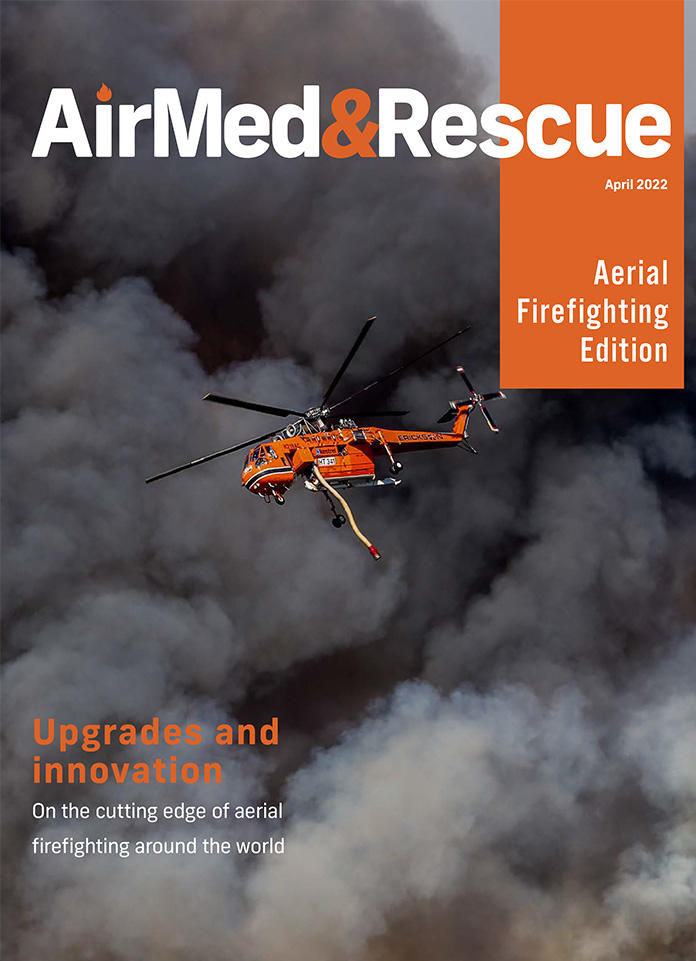Managing bariatric patients onboard air ambulances

Dr Joetey Attariwala looks at the challenges air ambulance providers face in safely transporting bariatric patients, and how better mission planning means better patient care
When it comes to bariatric (large/obese) patients, the primary concern in aeromedical transport is the physical size and weight of the patient, which could present difficulty in safe loading into an aircraft, and/or the ability of aeromedical crews to safely provide patient care within an aircraft's small treatment space.
For air ambulance providers, equipment and aircraft-specific limitations often mean that patients are considered ‘bariatric’ at a much lower weight than they would be in a hospital. Something that may seem simple in a hospital setting, such as patient positioning and routine repositioning, becomes extremely challenging for clinicians in a small aircraft with a patient on a relatively small stretcher.
As with all patients, airway management is of critical importance, and bariatric patients tend to be more difficult in this area as the range of motion in the cervical spine is often reduced
Speaking about the challenges that bariatric patients pose, Justin Pyke, Director of Paramedic Operations at Ornge, commented: “Ornge provides paramedics with equipment designed to address bariatric care for a number of procedures, but our focus is on delivering holistic care in a dignified and equitable way… More than simply individual procedures, the complexity of managing bariatric patients in transport involves managing all of the unique care needs in a mobile, confined environment.”
As with all patients, airway management is of critical importance, and bariatric patients tend to be more difficult in this area as the range of motion in the cervical spine is often reduced. To address this, aeromedical providers like Ornge have equipped all their aircraft with video laryngoscopes and have focused significant resources on difficult airway management. “We are continuing to advance our education for paramedics in caring for bariatric patients to ensure that the unique care needs of these patients are managed as well as the operational and logistical considerations,” added Pyke.
Most aeromedical operators have an overall load capacity for each flight, which cannot be exceeded. This includes the weight of crewmembers, equipment onboard, and the weight of the patient. Aeromedical providers like STARS, which operate their helicopters with a crew of four, use a general guide of 175kg (386lb) to assess if patient size might be a barrier for transport and care on their helicopters. “STARS has a policy to ask for an estimate of patient size and weight prior to accepting any mission request,” according to Cindy Seidl, Lead Clinical Officer at STARS. If metrics fall outside of parameters, 'the patient could be transported by ground ambulance accompanied by the STARS air medical crew.'
Managing care and transport expectations at a system level is a key challenge for bariatric transport. Healthcare facilities do not often have a recognition of the complexity and speciality of preparing for and transporting bariatric patients. An understanding of these complexities is important when understanding that moving bariatric patients safely may not always mean moving them quickly.
Some operators, like Midlands Air Ambulance in the UK, don’t actually have the capacity to directly handle bariatric patients, so they rely on partners, which in their case falls upon the West Midlands Ambulance Service.
“While the clinical team can deliver care, the enabling equipment is not something we have,” shared Helen Stevens, Communications and Marketing Manager on behalf of Midlands Air Ambulance Charity. “We work closely with West Midlands Ambulance Service who provide the necessary equipment and manual handling kit if we require it. They have specialist bariatric ambulances, so if we do require one for a patient, we utilize those.”

© Ornge
Lifting bariatric patients into and out of vehicles and aircraft is a very real challenge, particularly as trends are toward patient-centric operations that place the highest priority on the safety and comfort of the patient and paramedics/aircrew. Powered loading solutions in airframes make this possible without a compromise on aircraft performance.
HeliMods of Australia met this challenge head-on with their Powered Aero Loader (PAL), the world’s first patented solution delivering a zero-lift, push-button operated powered stretcher loader system used for rapid loading and unloading of road ambulance stretchers into helicopter emergency medical service (HEMS) aircraft. According to HeliMods, installation of the PAL is simple and intuitive. It has been designed for integration onto a variety of original equipment manufacturers (OEM) and aftermarket helicopter cabin floors, without any major structural modifications, and without the need for special tooling. Patients can be loaded from an ambulance or hospital helipad into a waiting HEMS aircraft in just 60 seconds by a single operator, without the need for manual handling. The PAL system is Federal Aviation Administration (FAA) Supplemental Type Certificate (STC) certified in the AW139 and the H145, and first entered operation in 2019 with launch customer Ornge.
“On the rotor wing operation, Ornge has invested in ensuring we have the right aircraft with the right equipment to maximize support for bariatric patients,” said Pyke. “Our AW139 helicopters are well equipped to handle bariatric patient operations. We have partnered with HeliMods to install a PAL system based on Stryker power equipment. This provides a no-lift solution to loading and securing of patients up to 700lb (318kg), depending on clinical equipment requirements.”
Detailing the PAL system was Brock Little of HeliMods: “Regarding bariatric patient loading, there is a definite preference for a powered loading solution such as PAL to reduce manual handling for paramedics. We are constantly working with aeromedical services to take out additional handling steps and unlocking opportunities for interoperability between air and road fleets. Fixed wing is trending in the same direction – powered loading should be the priority of operators whether they be rotary wing, fixed wing or a combination of both.”
“The entire product family is continually being updated with additional weight saving improvements. We are currently working with Ornge to develop accessories to the system for additional bariatric patient comfort including wider patient padded surfaces,” shared Little. “We are currently in the process of STC certifying it for the AW169 and achieving European Union Aviation Safety Agency (EASA) STC certification for the H145. There is a dedicated variant for the H145 that is suited to bariatric patient loading. The product is currently available for demonstration at operator bases, such that any interested parties can ground trial the solution in their current airframe.”

© STARS
Air Methods conducts over 70,000 transports and amasses over 150,00 flight hours a year in the US, and is instituting some new technologies to facilitate the efficient transport of patients, including some fresh approaches to the transport of bariatric patients.
“From our perspective, when dealing with bariatric patients, pre-planning is vital. If we know the weight, we’re then able to coordinate that with assets that we have available. In addition to rotary wing, our company has fixed-wing aircraft and bariatric ground ambulances, so we have options to maintain levels of critical care for heavy patients,” said Stephanie Queen, Senior Vice President of Clinical Services at Air Methods. “For rotary wing we have to be mindful of the weight of the crew, the patient, equipment, and also the distance, because that has implications on fuel and how far we’re able to travel. We’ve seen a lot of different hospital systems with restricted availability during Covid, so that’s been a challenge because we’re having to travel greater distances, which is why pre-planning is so important.”
As part of their approach to bariatric patient transport, Air Methods has positioned specific aircraft that can accommodate more weight, which they dub as ‘mega-movers’, at strategic locations throughout the US.
“Everything depends on distance and time, of course, but in general we’ve gotten away from the traditional A-Star. Aircraft like the H145 are larger and can accommodate more weight, so it’s all a matter of positioning assets where they make the most sense. We’re always evaluating what’s needed in different parts of the country for the tasks they’re likely to do,” said Queen. “In addition, we have fixed-wing aircraft that have hoists and lifts that can lift larger patients more safely – a lot of our Pilatus PC-12 aircraft are equipped with those, and we’re looking to standardize that across the country.”
One of the new tools that Air Methods is using to manage patients is called Mission Control, which is developed by Motient.
“Motient gives each patient an acuity score to either go by air or by ground,” said Queen. “That software, for us, has been a game changer. It’s a phenomenal asset to have to determine means of transport for all patients, certainly bariatric patients, and to know bed availability across various locations.”
In 2021, front-line workers at 115 Kansas hospitals used the application to complete a total of 5,100 interfacility transfers to more than 200 receiving hospitals across the state and beyond. “Kansas is providing a framework for public-private healthcare collaboration that other states can emulate,” said Dallan Huff, President of Motient. “By helping frontline workers facilitate efficient patient transfers, Kansas is helping to ensure the delivery of top-notch emergency services for every resident in need.”
The company’s Mission Control software is vendor-neutral, and thus far has coordinated transport services via more than 130 different patient transport vendors. In 2021, 52 per cent of Motient’s patient transfer requests required ground transport, while 48 per cent of patients were transferred by air transport vendors, including Air Methods.
“Motient helps providers ensure the appropriate patients are being transferred to the appropriate facilities by the correct means of transportation, whether that be ground or air,” said Huff. “In rural communities, emergency air medical transport is often crucial for high-acuity patients who need immediate access to a Level I or Level II trauma center. Motient handles the logistics of quickly engaging an available vendor.”
Bariatric patients certainly pose challenges to aeromedical crews, but one can see that proper planning, along with the advancement of lifting and medical technologies, means these patients are receiving better care than ever before.

April 2022
Issue
This edition of AirMed&Rescue contains in-depth analysis of firefighting aircraft and equipment innovation, the pros and cons of amphibious and land-based air tankers, using drones as fire surveillance machines, and the issue of federal versus state coordination of aerial firefighting assets in the US.
Dr Joetey Attariwala
Dr Attariwala trained as a medical doctor and has established himself as a highly regarded journalist who contributes to various aerospace, defense, training and simulation, and law enforcement publications around the world. He is a regular contributor to AirMed&Rescue magazine.




